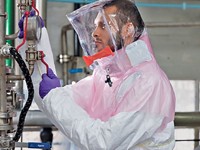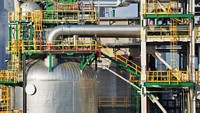Advertisement
Grab your lab coat. Let's get started
Welcome!
Welcome!
Create an account below to get 6 C&EN articles per month, receive newsletters and more - all free.
It seems this is your first time logging in online. Please enter the following information to continue.
As an ACS member you automatically get access to this site. All we need is few more details to create your reading experience.
Not you? Sign in with a different account.
Not you? Sign in with a different account.
ERROR 1
ERROR 1
ERROR 2
ERROR 2
ERROR 2
ERROR 2
ERROR 2
Password and Confirm password must match.
If you have an ACS member number, please enter it here so we can link this account to your membership. (optional)
ERROR 2
ACS values your privacy. By submitting your information, you are gaining access to C&EN and subscribing to our weekly newsletter. We use the information you provide to make your reading experience better, and we will never sell your data to third party members.
Business
All About Amines
Belgium’s Taminco expands by scooping up amine-related assets around the world
by Michael McCoy
July 5, 2010
| A version of this story appeared in
Volume 88, Issue 27

As a First Step Toward exiting chemicals and becoming a pure drug company, the Belgian chemicals and pharmaceuticals group UCB divested its business in alkylamines in 2003. Other chemical companies didn’t seem interested in the stagnating business, and it was picked up by a private equity firm.
Today, that business is the world’s largest alkylamines producer. It’s three times its original size and much more profitable. Called Taminco, for “The Amine Company,” it is the rare example of a chemical company that actually improved its earnings last year.
The story of Taminco is the story of how a business, untethered from corporate constraints, can blossom. In Taminco’s case, it did so mainly by buying up amines-related businesses from multinational chemical companies and folding them into its own production network.
The mover behind this strategy was Pol Vanderhaeghen, who joined UCB in 1973 and led Taminco from its start. In January, he passed the torch to Laurent Lenoir, a 19‑year veteran of UCB and Taminco. Although Vanderhaeghen is staying on as chairman, it falls mainly to Lenoir to continue expanding Taminco now that it has picked most of the low-hanging fruit in the amines world.
When Taminco was spun off, it had annual sales of about $260 million and 500 employees. Its first deal, the 2004 purchase of Air Products & Chemicals’ European methylamines and derivatives business, established its modus operandi. As Lenoir explains, Taminco bought a business but no assets. Air Products shut down its methylamines plant in Billingham, England, leaving Taminco to supply the new customers from its existing facilities in Ghent, Belgium, and Leuna, Germany.
It did the same thing in 2006, buying AkzoNobel’s business in methylamines and choline chloride, an amine derivative used in animal feed. Akzo then closed its plants in Delfzijl, the Netherlands.
Taminco departed from its strategy later that year when it entered the Americas market by purchasing Air Products’ remaining amines operations. The business, Taminco’s largest acquisition, had sales of $310 million and included plants in Pace, Fla.; St. Gabriel, La.; and Camaçari, Brazil.
Taminco returned to form in 2007 when it acquired Arkema’s U.S. business in higher amines and alkylalkanolamines. The $60 million-per-year operation did include a plant, in Riverview, Mich., but by late last year Taminco had shut it down. According to Lenoir, the company is just now completing the consolidation of the former Riverview product line into its St. Gabriel site.
Yet another consolidation occurred last year when Taminco acquired two amine-based rubber polymerization accelerators, tetramethylthiuram disulfide and tetraethylthiuram disulfide, from Solutia’s Flexsys subsidiary.
Folding amines operations from four other companies into one has had a noticeable impact on Taminco’s finances. Its sales last year reached $817 million, more than triple what they were when it launched, but its staff grew by only about 50%, to 770 employees. Operating profits were $110 million, up 38% over 2008. Debt, meanwhile, fell modestly year over year.
“In 2009, we saw the result of the full synergies between all the acquisitions that we did,” Lenoir says. Taminco was also fortunate, he notes, to have customers in markets such as personal care, water treatment, oil and gas, and nutrition that were relatively insensitive to the economic turmoil of 2009 and late 2008.
Outsiders are generally impressed by what the company has accomplished. “I think they surprised everybody,” says Ian Williams, head of Acid-Amine Technologies, a Woodcliff Lake, N.J.-based firm that develops and licenses amine, amide, and acid process technology. “Nobody expected the embodiment of UCB to progress the way Taminco has.”
Still, Williams wonders how Taminco will maintain its growth trajectory, given that the firm has bought many of the obvious acquisition targets. In the U.S. and Europe, its biggest competitor today is BASF, the world’s largest chemical company. “There are one or two on their target list, but they are quite small,” Williams observes of Taminco.
Lenoir responds that Taminco has a lot more growing to do, and that one obvious place to do it is in Asia. Today, the firm’s sales are split about 40% each in the U.S. and Europe and 10% each in Latin America and Asia. He’s out to make the Asia share larger.
Taminco operates two plants in China, one built by UCB and one acquired from AkzoNobel in 2007. Both produce choline chloride, a vitamin-like animal feed additive that’s made by reacting ethylene oxide, hydrochloric acid, and trimethylamine. Lenoir’s goal is to get into other downstream products in China and later back-integrate into basic amines manufacturing.
The trick is navigating a dynamic landscape. China is “a market where you have a lot of industrial players in very different states,” he says. “You have very modern players and you have older ones, and there is a rationalization process going on.”
Taminco also seeks to grow internally by developing new products and new markets. In 2005, the firm opened an R&D building at its Ghent headquarters where it maintains a research, technology, and development team of 35 people.
Lenoir is particularly bullish on agricultural opportunities. Last year, the company debuted a new, free-flowing version of choline chloride, which it calls Taminizer C. This year it will launch an entirely new amine-based feed additive, N,N-dimethylglycine. Known as Taminizer D, it was developed in cooperation with several European universities. The firm is also developing amine-based biostimulants intended to spur plant growth.
Other potential growth areas include the oil and gas industry: Taminco claims that alkylamines are a less corrosive means of removing unwanted hydrogen sulfide from oil and gas than traditional ethanolamines. For the paint industry, Taminco is developing Vantex-T, an amine-based additive that can replace solvent-containing neutralizing and coalescing agents. And Synergex T is a new N-alkylalkanolamine additive for metalworking fluids touted as boosting performance.
Although the future seems bright for Taminco, there’s one dark cloud in its recent past: the cancellation earlier this year of a planned initial public offering (IPO) of stock.
For a company owned by private investors—the 2003 buyout from UCB was backed by a Dutch private equity firm, which sold it four years later to CVC Capital Partners for about $1.1 billion—an IPO is the logical endgame. Taminco began its preparations last year. “Looking at the size of the company and the consistency of its results in a difficult environment, we thought it was an interesting proposal for investors,” Lenoir explains.
In early 2010, Taminco announced that it planned to file for a listing on the Brussels stock exchange. It formally began the IPO process later in January, but on Feb. 3, it canceled the offering, announcing that market conditions were unfavorable.
Lenoir was disappointed, but he maintains that Taminco’s owners could afford to say no when it became clear that the market wasn’t going to value the firm appropriately. “Since there was no urgency for Taminco to find an exit, we decided to pull out and refocus on the business,” he says.
There’s still no urgency, Lenoir adds. “We will look at exit opportunities when they come and the timing is right,” he states. The firm’s cash flow—almost $200 million last year—is enough to support continued expansion, including investment in China should an opportunity arise.
And Lenoir is comfortable with Taminco’s continued concentration on amines. “We are the first to focus fully on that niche,” he says. “We see ourselves still in our core business of amines going forward. It has delivered profitable growth up till now.”





Join the conversation
Contact the reporter
Submit a Letter to the Editor for publication
Engage with us on Twitter